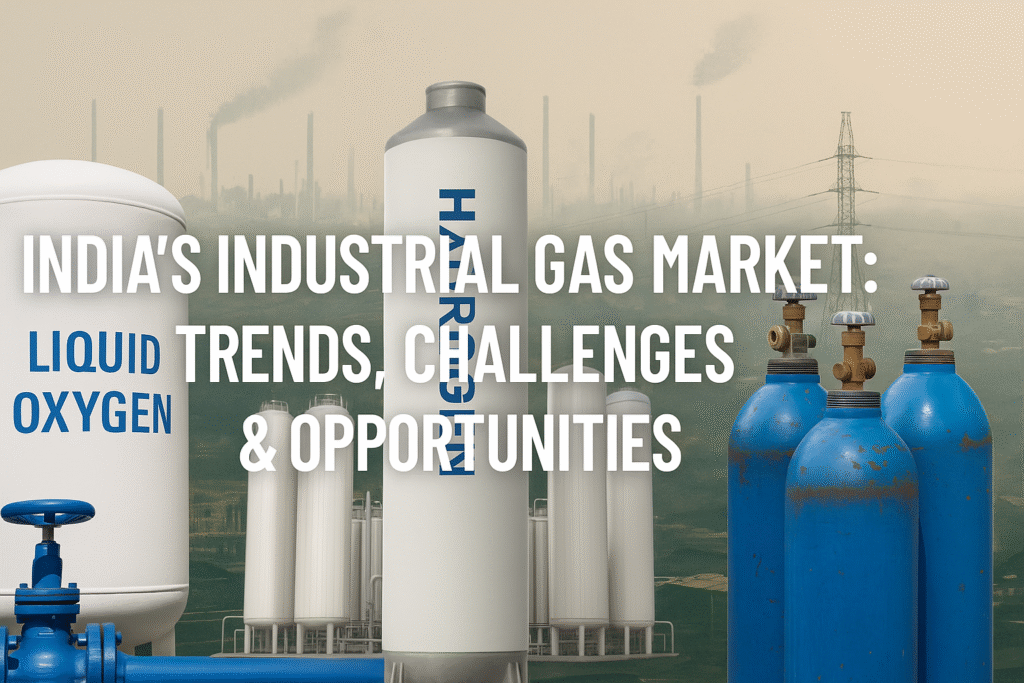
Introduction
India’s industrial gas market is undergoing a significant transformation, driven by rapid industrialization, decarbonization goals, and innovations in sectors like healthcare, energy, and manufacturing. Industrial gases such as oxygen, nitrogen, hydrogen, and carbon dioxide are critical to industries ranging from steel and chemicals to pharmaceuticals and electronics. This blog explores key market trends, challenges, and emerging opportunities shaping the future of India’s industrial gas sector.
Current Trends in India’s Industrial Gas Market
1. Growing Demand Across Core Industries
- The steel and metal fabrication industries remain the largest consumers of oxygen and argon.
- Pharmaceuticals and healthcare have seen a surge in oxygen and nitrogen use post-COVID-19.
- Electronics and semiconductors are driving demand for ultra-high purity gases like nitrogen and argon.
2. Green Hydrogen Adoption
- India is moving toward cleaner energy alternatives like green hydrogen.
- The government’s National Green Hydrogen Mission (₹19,744 crore budget) aims to make India a global hub for green hydrogen production and export.
3. LNG and Cryogenic Infrastructure Expansion
- Investments in cryogenic storage and transport systems are increasing for liquefied industrial gases.
- Floating LNG terminals and cryo-tankers are being deployed in ports like Haldia and Ennore.
4. Digitalization and Smart Monitoring
- Companies are adopting IoT-enabled sensors for real-time gas monitoring and predictive maintenance.
- Cloud-based supply chain systems are improving delivery efficiency and reducing operational costs.
Key Challenges in the Industrial Gas Sector
1. Infrastructure Bottlenecks
- Limited pipeline networks for gas transportation lead to dependence on cylinders and trailers.
- Rural and Tier-II areas lack cryogenic refilling and storage facilities.
2. Price Volatility and Import Dependency
- India imports a significant portion of helium and specialty gases, making prices volatile.
- Raw material and energy costs affect price stability of gases like acetylene, CO₂, and argon.
3. Regulatory and Licensing Complexities
- Compliance with PESO, OISD, and environmental clearances adds to project delays.
- Frequent updates in safety standards and ISO regulations demand continuous adaptation.
4. Skilled Workforce Shortage
- Lack of trained professionals in gas handling, cryogenics, and plant automation limits scaling and safety.
Emerging Opportunities in the Indian Gas Market
1. On-site Gas Generation Systems
- Hospitals, food processing units, and manufacturing plants are investing in on-site oxygen and nitrogen generators to reduce dependency on bulk suppliers.
2. Waste-to-Gas Projects
- Biogas and syngas production from agricultural and municipal waste offer alternative energy sources and reduce carbon emissions.
3. Hydrogen Economy Growth
- Startups and energy giants are exploring blue, grey, and green hydrogen for mobility and industrial heating.
- Government incentives and private sector R&D are boosting domestic electrolyzer production.
4. Export Potential
- India’s location and production capabilities position it to export specialty gases to the Middle East, Southeast Asia, and Africa.
- Demand for electronic-grade and food-grade gases is rising in overseas markets.
Government Initiatives and Policies
- National Green Hydrogen Mission – Boosts clean hydrogen R&D and infrastructure.
- Production Linked Incentives (PLI) – Encourages electronics and semiconductors that require high-purity gases.
- PESO & SMPV (U) Rules – Set safety and licensing norms for gas transport and storage.
- Make in India & Aatmanirbhar Bharat – Support indigenous gas equipment and plant manufacturing.
Future Outlook
India’s industrial gas market is expected to grow at a CAGR of 8–10% over the next five years, with significant momentum in renewable energy, steel, and healthcare. By investing in infrastructure, safety systems, and digital transformation, India can become a global powerhouse in both industrial and specialty gas production.
Conclusion
The industrial gas market in India is at a turning point. As the country balances growth, sustainability, and innovation, players across the value chain must align with evolving demand, regulatory shifts, and technological advancements. Whether it’s green hydrogen, medical oxygen, or high-purity gases for semiconductors, India’s gas sector offers dynamic opportunities for long-term success.
References




